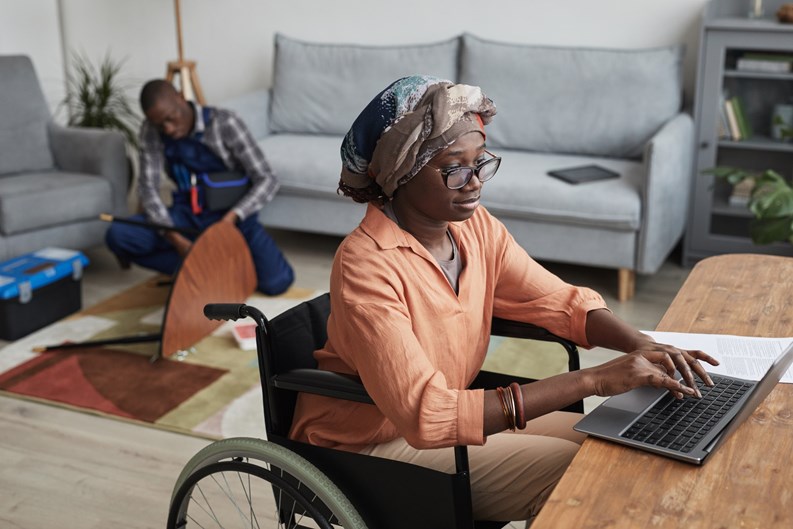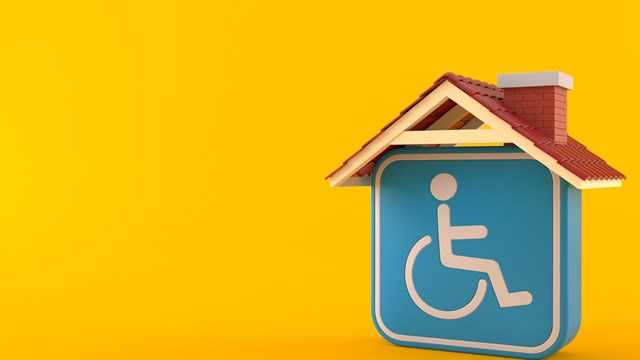The idea that ‘form follows function’ is one of the basic concepts underlying nearly every design discipline—but function for whom? For many people living with disabilities, it often seems that ‘function’ covers a very narrow range of ability—rendering many forms clumsy at best, and completely useless at worst. While a cascading stairway might provide drama to a public space, for example, it may present an insurmountable obstacle to anyone making use of a wheelchair or other mobility aid.
While in the past accessibility for differently-abled individuals may have been an afterthought (if it was a thought at all), in recent years, architects and designers have begun to change their view of how to best achieve form and function for everyone, regardless of age or ability. Two key drivers of that change were the adaptation of the theory of Universal Design, and the passage and implementation of the Americans with Disabilities Act (ADA).
Universal Design
“Universal Design was developed in 1997,” says Eric Cohen, senior associate principal at Ethelind Coblin Architect, an architecture and design firm based in New York with clients throughout New England as well. “It was the brainchild of a working group of architects, product designers, engineers, and environmental design researchers led by Ronald Mace at North Carolina State University.
Universal Design is the design and composition of an environment so that it can be accessed, understood, and used to the greatest extent possible by all people regardless of their age, size, and ability. It is a fundamental process of good design.”
Cohen goes on to explain that there are seven principles of Universal Design: equitable use, flexibility in use, simple and intuitive use, perceptible information, tolerance for error, low physical effort, size and space for approach and use. Taken together and applied, these principles ensure that an environment can be used in the most independent and natural way, in the widest possible range of situations, by the broadest array of users, without special adaptation, modification, or specialized solutions. They can be applied to evaluate existing designs, to guide new ones, or to educate designers and consumers.
Jonathan Baron, principal of Manhattan-based Jonathan Baron Interiors, works with clients across the country, including New England, and explains the movement in simple terms. “The concept came out of architects’ and interior designers’ concerns about meeting the needs of everyone, including mildly to severely disabled people. Something as simple as a cane or walker would have access to any space from a kitchen or bath to common areas such as lobbies and hallways. In the early 1990s this became a trend. It was the moment where the design industry took on the moral and ethical responsibility of this challenge. We weren’t going to design just anything anymore. It’s about ‘comfortable’ use. Form follows function. It is a commitment to meet the needs of everyone.”
Enter the ADA
Universal Design is a movement—not a federal statute or mandatory code. The ADA, on the other hand, is the law. Baron explains that the Americans with Disabilities Act was passed and signed into law in July 1990 by then-President George H.W. Bush. ADA compliance enforcement followed, with failure to meet the new requirements resulting in costly legal action. Failing to make spaces and facilities accessible to those with disabilities was considered discriminatory.
Of course, the tenets of Universal Design incorporate the same principles and values enshrined in the ADA— and according to Cohen, architects and designers integrate Universal Design and the ADA requirements all the time. “We use codes as a guide for compliance with agencies having jurisdiction but make the process specific to the location and client,” he says. “It is not a one-size-fits-all approach. We start by understanding the users and asking questions about what they find most challenging. We talk to residents as well as staff. Some of this happens by asking, and some by observing.
“The design process itself is interactive and layered, and takes many factors into consideration,” Cohen continues, “including things like spatial clearances and mobility impediments. Ease of navigating the space; differentiating between public, private, service and emergency egress, and finding direction; an understanding of the varied characteristics and abilities of users’ mobility, sensory, cognitive, as well as what is familiar to them; appropriate selections of flooring finishes, lighting, surface finishes on ceilings, walls, floors, and transaction surfaces to avoid glare, slippery floor surfaces. You also address acoustics and palette, to provide balanced contrast in light/dark, hue, and pattern. It’s also important to address the things that aren’t as apparent as disabilities, such as mental health issues and cognitive issues, and to respond to neurodiversity. Appropriate furniture and selections to accommodate a range of sizes and abilities. Arms on chairs, seating height and depth.”
Baron illustrates how ADA considerations affect decisions about and the execution of Universal Design projects. “There are codes that determine how space must function to meet the needs of the mobility impaired,” he says, “and co-ops and condos must be careful that they are adhering to those codes. For instance, you have a front entrance to a building. There are code requirements for ramps; doors must open outward, and there are mandatory heights for handles, as well as requirements for the width of the doors, which must be at least 36 inches to accommodate wheelchairs. Stairs may also be an issue for the mobility impaired. For people with vision impairments, there are signs in braille. For the hearing impaired, everything is visual.”
For older buildings built long before the ADA was even a concept, there may be some wiggle room, Baron says. “It should be noted that some buildings are grandfathered in—but if and when they redesign their public areas, they need to be careful about what choices they make, since an architectural change to the building may trigger ADA compliance requirements. That can be very expensive.”
Cost vs. Compliance
Baron points out that while many older buildings are grandfathered in under the ADA and therefore not mandated to comply with the Act’s specifications, even if they wanted to update their spaces, the cost of doing so may be prohibitive. This is particularly true for smaller prewar co-ops and condos, and those whose residents are on fixed incomes.
These communities, says Baron, “normally function pretty well, so I suggest they avoid triggering ADA requirements. Co-ops and condos don’t want to trigger the costs involved or lose their entire lobby to a ramp, so we’ll often look for another ingress/egress option, or perhaps recommend a collapsible ramp. My advice is to be ‘conservative’ in remodeling your space in ways that might trigger ADA requirements.”
By contrast, Baron continues, buildings with more services may be able to make meaningful updates without necessarily incurring exorbitant expenses. “For example, if you have services like a concierge desk, when you’re building a new desk or replacing an existing one, it might be designed as a dual-level surface with a 42-inch-high surface for standing individuals and a 30-inch-high surface for individuals using wheelchairs. This is where ADA compliance and Universal Design meet.”
Cohen reiterates that “the ADA was initiated as a civil rights act, not as a prescription of dimensional code requirements” and stresses that understanding the users of a space and what they want and need is what is most important. He points to New York City’s Inclusive Design Guidelines, which the city’s Department of Design and Construction publishes in collaboration with the Center for Inclusive Design & Environmental Access at the State University of New York (SUNY) Buffalo as “an outstanding example of a document that meshes an understanding of accessibility codes with the nuances of how differently-abled users make use of spaces and facilities,” from those with mobility challenges to those of varied heights, including children. “Each section describes recommended characteristics but also includes advisory notes that allow for nuances in consideration.” A full PDF of the guidelines can be found here: https://www1.nyc.gov/assets/ddc/downloads/publications/guides-manuals/universal-design-ny.pdf
In the final analysis, Universal Design—design for everyone—is a concept whose time is definitely here, but also one that has evolved organically over decades. It has also meshed and grown with the practical implications of the Americans with Disabilities Act to make real and lasting changes in how we build, what we build, and who we build it for.
A J Sidransky is a staff writer/reporter for New England Condominium, and a published novelist.










Comments
Leave a Comment